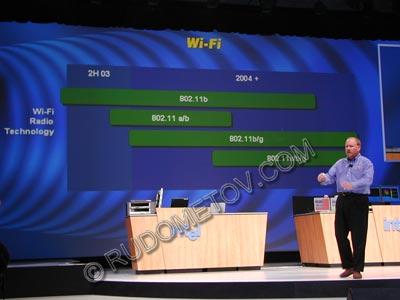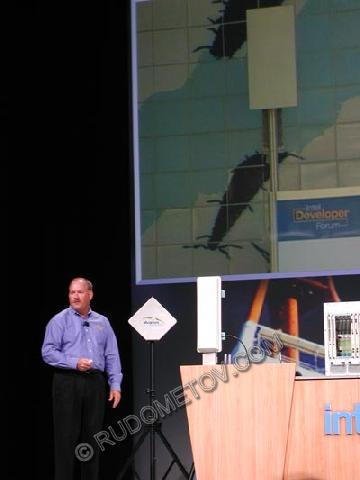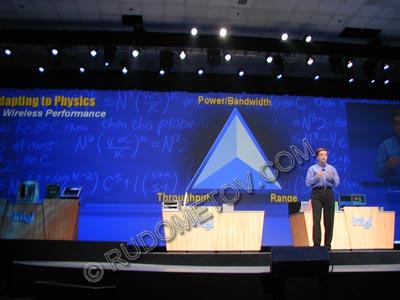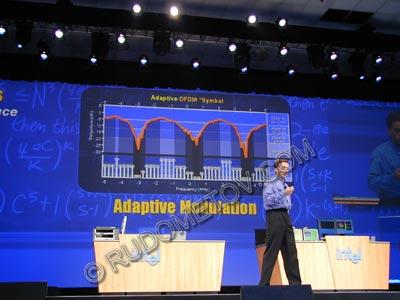It is published on site Fcenter
IDF Fall 2003, final day
Victor Rudometov.
authors@rudometov.com
 On September, 18th, 2003 in San Jose (California, the USA) has completed operation of Intel Developer Forum (IDF) - the largest international developer forum hardware and the software. The last day, as always was, is complete announcements of new products and the perspective processing techniques presented during performances of leading experts of branch.
On September, 18th, 2003 in San Jose (California, the USA) has completed operation of Intel Developer Forum (IDF) - the largest international developer forum hardware and the software. The last day, as always was, is complete announcements of new products and the perspective processing techniques presented during performances of leading experts of branch. 

On such representative action as IDF it is difficult to select someone from lecturers. But there are no doubts, that all liking Patrick Gelsinger with the key report on researches and developments (R&D - Research and Development) has traditionally got Intel corporations.



 Fig. 1. The Conference hall: instead of habitual rows of chairs
Fig. 1. The Conference hall: instead of habitual rows of chairs
 Desktops are installed
Desktops are installed

However before it (Eric Mentzer), holding a post of the vice-president of corporation of Intel and responsible Eric Menttser has appeared in network processing techniques.


Eric spoke about networks, has told about tendencies of their future development. Logical continuation of evolution of networks on the basis of copper explorers is the optical fiber. However and it in the near future will substitute promptly developing wireless processing techniques.



 Fig. 2. Wireless communication perspectives
Fig. 2. Wireless communication perspectives

The greatest distribution at present receives the standard 802.11b. By the end of year the arrangements combining at once all three types of wireless networks 802.11 a, b and g (802.11a/b/g) will be released. Thus the new standard 802.11g has such properties, that at removal from the handling aerial on 50, 100, 150, 200 metres, capacity of a network remains approximately at one level.


During performance the lecturer has acquainted with the future standard of a wireless communication - 802.16a. Range of operation will increase to 30 miles (48 kilometres) that takes up a position a network as WWAN (Wireless Wide Area Network). The Transfer rate will make 75 Mbps, that ideally approaches for high-speed networks, transmission of video, the vocal information and other applications.


At the given stage widely there is an operation on licensing of used frequencies (2-11 GHz). As Eric Menttser has underlined, the industry feels requirement for the standard with the given characteristics, therefore reception of licences, in its opinion, will not be the big problem.



 Fig. 3. A wireless network 802.16a
Fig. 3. A wireless network 802.16a

If a series of standards 802.11 had name WiFi new 802.16 will be named WiMAX.



 Fig. 4. Eric Mentser near to the antenna and base server
Fig. 4. Eric Mentser near to the antenna and base server

In conclusion of Eric Mentsera's performance the small presentation has been led. During this presentation the visual communication with the employee of Intel who is in the bus with equipment of a wireless communication who stood at this time in the street has been installed.



 Fig. 5. A videoconference with wireless bus
Fig. 5. A videoconference with wireless bus

Then Patrick Gelsinger (Patrick Gelsinger), the vice-president and the leading technologist of corporation Intel has appeared.


He has told about program Radio Free Intel - the project of corporation of Intel on integration of radio arrangements into processors and chip sets. It will allow to create adaptive radio platforms which will make wireless communications widespread.


As the lecturer has marked, first of all, it is necessary to create processing technique, adaptive to physical parametres. As such parametres appear: capacity, a frequency band, range of operation.



 Fig. 6. Adaptability to physical parametres
Fig. 6. Adaptability to physical parametres

Then it is necessary to realise adaptability to network parametres. It means, that the network should be customised on peak values of cumulative and user's productivity. Besides, hardware-software resources of a network provide cost and cover zone best values.



 Fig. 7. Adaptability to network parametres
Fig. 7. Adaptability to network parametres

As an example of implementation of hardware of a network the processing technique of changeable modulation thanks to which it is possible to raise quality of a signal essentially has been shown. It is necessary to mark, that the given processing technique was accessible and earlier, but possibility to use it appears only now, thanks to the growing computational capabilities provided with development of solid-state technologies.


It is necessary to make for application of adaptive modulation in real time enormous calculations. The processors capable of it, appear just now.



 Fig. 8. Adaptive modulation
Fig. 8. Adaptive modulation

The following novelty are so-called “clever aerials” (Smart Antenna). It is natural, that from time to time the aerial is necessary for setting up: environing conditions (for example, weather), requirements vary, etc. Here it is necessary to mark, that in the aerial past customised, as a rule, manually. Now current technologies allow to fulfil this operation everyone some milliseconds in an automode. As a result of it optimal conditions for data transfer are provided.


If to apply not one, and some priemo-handling installations (MIMO - multiple input multiple output) it is possible to achieve essential increase of quality of a signal and capacity. It also has been shown directly on the bench.



 Fig. 10. One transmitter and one receiver
Fig. 10. One transmitter and one receiver


 Fig. 11. Some transmitters and receivers
Fig. 11. Some transmitters and receivers

As result in the first case capacity 2.4 Mbps has been reached. At usage of several receivers and transmitters this digit has increased to 4.9 Mbps.



 Fig. 12. A new oscillator
Fig. 12. A new oscillator

Patrick Gelsinger has informed on successful development of radio components for a radio communication with usage of digital CMOS-processing techniques, including the fastest in the world the controlled generator. The generator is responsible for creation of frequencies with which radio signals are handled and accepted. The presented generator functions on frequencies over 75 GHz.


In summary it would be desirable to mark, that on the given report many other things have been presented also interesting both perspective processing techniques and products, however, it is a subject for separate article in the future.

To pass to razrelu Processors